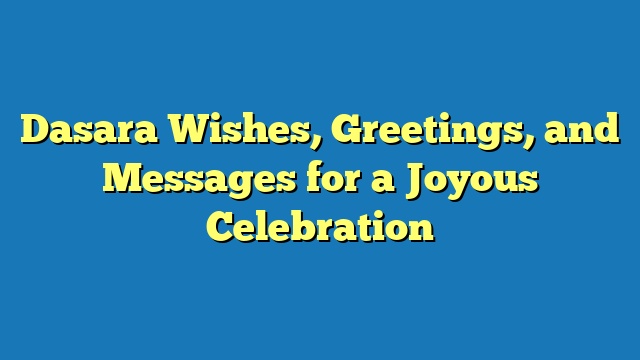Dasara wishes greetings messages, epitomizing the spirit of the auspicious occasion, convey heartfelt expressions of joy and prosperity. For instance, “May the blessings of Goddess Durga illuminate your path and bring you happiness and fulfillment.” These messages honor the triumph of good over evil, reinforcing the significance of this revered festival.
Beyond conveying well wishes, Dasara messages serve as a medium to strengthen bonds, fostering a sense of community. They embody the collective spirit of hope and renewal, a lifeline during challenging times. Historically, the festival’s association with royalty and victory has contributed to its grandeur, shaping the cultural significance we witness today.
This article delves into the rich tapestry of Dasara wishes, greetings, and messages. Exploring their composition, evolution, and contemporary relevance, we will uncover the nuances that make them an integral part of this cherished celebration.
Dasara Wishes Greetings Messages
Dasara wishes, greetings, and messages form an integral part of celebrating this auspicious festival. These key aspects collectively contribute to the significance and essence of Dasara.
- Cultural Significance: Reflecting the triumph of good over evil.
- Religious Symbolism: Celebrating Goddess Durga’s victory over Mahishasura.
- Community Bonding: Strengthening ties through shared festivities.
- Historical Legacy: Rooted in ancient traditions and legends.
- Emotional Expression: Conveying joy, prosperity, and hope.
- Social Harmony: Promoting unity and goodwill among people.
- Literary Finesse: Often expressed through heartfelt poems and messages.
- Artistic Inspiration: Encouraging creativity in art, music, and dance.
These aspects are deeply intertwined, creating a multifaceted tapestry of Dasara wishes, greetings, and messages. They serve not only as expressions of goodwill but also as a means to preserve cultural heritage, foster community spirit, and inspire artistic expression. Understanding these key aspects provides a deeper appreciation for the richness and significance of this cherished festival.
Cultural Significance
Within the context of Dasara wishes, greetings, and messages, the cultural significance holds immense weight. It encapsulates the essence of the festival, capturing the victory of good over evil. This triumph is a central theme that weaves its way through various aspects of Dasara celebrations.
- Mythological Roots: Dasara draws inspiration from the epic battle between Goddess Durga and the demon Mahishasura. The wishes, greetings, and messages often reference this mythological tale, highlighting the triumph of righteousness over evil.
- Symbolic Effigies: During Dasara, effigies of Ravana, the epitome of evil, are burned. This symbolic act represents the destruction of all that is negative and the victory of good.
- Dussehra Greetings: Traditional Dasara greetings convey the message of “Vijayadashami,” meaning the victory of good over evil. These greetings are exchanged to spread positivity and hope, reminding people of the triumph of righteousness.
- Artistic Expressions: Dasara inspires various forms of art, such as dance, music, and theater. These artistic expressions often depict the battle between good and evil, reinforcing the cultural significance of the festival.
In essence, the cultural significance embedded in Dasara wishes, greetings, and messages serves as a reminder of the eternal struggle between good and evil. It highlights the importance of upholding righteousness and reinforces the belief that good will ultimately prevail.
Religious Symbolism
Religious symbolism plays a pivotal role in shaping the significance and content of Dasara wishes, greetings, and messages. The victory of Goddess Durga over the demon Mahishasura forms the cornerstone of this symbolism, influencing various aspects of the festival’s communication.
Mythological Foundation: Dasara wishes, greetings, and messages often draw inspiration from the mythological tale of Goddess Durga’s triumph over Mahishasura. This victory symbolizes the triumph of good over evil, a message that resonates deeply within the festival’s greetings.
Devotional Expressions: Many Dasara wishes and greetings include devotional phrases and prayers dedicated to Goddess Durga. These expressions honor the goddess’s power and seek her blessings for victory and protection. For instance, “May Maa Durga bless you with strength, wisdom, and prosperity.”
Artistic Representations: The symbolism of Goddess Durga’s victory is often depicted through various art forms during Dasara. Paintings, sculptures, and dance performances showcase the goddess’s fierce battle with Mahishasura, reinforcing the religious significance of the festival.
Understanding the connection between religious symbolism and Dasara wishes, greetings, and messages provides a deeper appreciation for the festival’s spiritual essence. It highlights the importance of celebrating the victory of good over evil, seeking divine blessings, and expressing devotion through artistic expressions.
Community Bonding
Dasara wishes, greetings, and messages play a crucial role in fostering community bonding, strengthening ties through shared festivities. These greetings and messages serve as a medium for expressing well wishes, conveying blessings, and spreading joy during the festive season.
One of the key aspects of community bonding is the sense of belonging and shared experiences. Dasara wishes and greetings contribute to this by creating a shared platform for individuals to connect and celebrate together. Exchanging messages and greetings during this time allows people to feel a sense of unity and belonging to a larger community.
Furthermore, these wishes and greetings often extend beyond immediate family and friends, fostering connections within the broader community. People exchange messages with neighbors, colleagues, and acquaintances, spreading the festive spirit and strengthening social bonds. This exchange of well wishes helps create a positive and inclusive atmosphere, promoting harmony and goodwill.
In conclusion, the connection between “Community Bonding: Strengthening ties through shared festivities” and “dasara wishes greetings messages” is evident in the role these messages play in fostering a sense of belonging, shared experiences, and extending connections within the community. Understanding this relationship highlights the importance of Dasara wishes and greetings as a means of strengthening community bonds and promoting social harmony.
Historical Legacy
The historical legacy of Dasara is deeply intertwined with the wishes, greetings, and messages exchanged during this festival. This legacy is rooted in ancient traditions and legends, which have shaped the content and significance of these communications over centuries.
The story of Goddess Durga’s victory over the demon Mahishasura forms the mythological foundation of Dasara. This victory symbolizes the triumph of good over evil, a theme that is reflected in many Dasara wishes and greetings. For example, people often wish each other “Vijayadashami ki hardik shubhkamnayein,” which means “warm wishes on the occasion of Vijayadashami,” the day that marks the culmination of Dasara.
Another important aspect of Dasara’s historical legacy is the association of the festival with royalty and victory. In ancient times, kings and warriors celebrated Dasara as a symbol of their military prowess and prayed for victory in battle. This association is still reflected in some Dasara wishes and greetings, which express hope for success and prosperity.
Understanding the historical legacy of Dasara provides a deeper understanding of the significance of the wishes, greetings, and messages exchanged during this festival. These communications serve not only as expressions of goodwill but also as a way to connect with the rich cultural and historical traditions of India.
Emotional Expression
In the context of “dasara wishes greetings messages,” emotional expression plays a significant role in conveying the spirit of the festival. Dasara wishes and greetings are not merely formal messages but heartfelt expressions of joy, prosperity, and hope, reflecting the sentiments of the occasion.
-
Expressions of Joy:
Dasara wishes often convey heartfelt joy and happiness, celebrating the triumph of good over evil. People exchange greetings like “Wishing you a joyous and prosperous Dasara filled with happiness and blessings.”
-
Prayers for Prosperity:
Many Dasara wishes include prayers for prosperity and abundance. People express their hopes for financial well-being, success in endeavors, and overall prosperity during the festive season.
-
Messages of Hope:
Dasara greetings also carry messages of hope and renewal. They symbolize the victory of good over evil and inspire people to stay positive and hopeful during challenging times.
-
Conveyance of Gratitude:
Dasara wishes sometimes express gratitude for the blessings received and the presence of loved ones. People acknowledge the support and love they have received and wish for continued happiness and prosperity.
These facets of emotional expression collectively contribute to the richness and significance of “dasara wishes greetings messages.” They not only convey well wishes but also reflect the spirit of joy, prosperity, hope, and gratitude that is central to the festival of Dasara.
Social Harmony
Within the context of Dasara wishes, greetings, and messages, the aspect of Social Harmony takes center stage, reflecting the festival’s ability to promote unity and goodwill among people. This harmony manifests in various ways, fostering a sense of togetherness and mutual respect.
- Community Bonding: Dasara wishes and greetings act as a bridge, connecting people from all walks of life. Exchanging these messages strengthens community ties, fostering a sense of belonging and shared experiences.
- Cultural Exchange: Dasara greetings often embody cultural nuances and traditions, providing an opportunity for people to appreciate and learn about diverse customs and practices. This exchange promotes mutual understanding and cultural harmony.
- Dispelling Differences: The spirit of Dasara transcends social and economic boundaries, uniting people under a common thread of celebration. Dasara wishes and greetings play a role in breaking down barriers, promoting equality, and encouraging inclusivity.
- Peace and Unity: The messages of hope and prosperity conveyed through Dasara greetings contribute to a collective sense of optimism and well-being. These messages spread positivity, reinforcing the importance of peace, unity, and cooperation.
In essence, the Social Harmony aspect of Dasara wishes, greetings, and messages is a testament to the festival’s power to bring people together. It fosters a sense of community, cultural exchange, inclusivity, and overall well-being, reinforcing the bonds that unite humanity.
Literary Finesse
The literary finesse of Dasara wishes, greetings, and messages adds a touch of elegance and depth to the festive communication. It manifests in various forms, each contributing to the expressive richness of these messages.
-
Poetic Expressions:
Dasara greetings often take the form of heartfelt poems, capturing the essence of the festival through rhythmic verses. These poems convey blessings, good wishes, and prayers in a creative and memorable way.
-
Figurative Language:
The use of figurative language, such as metaphors and similes, enhances the impact of Dasara messages. These literary devices create vivid imagery, evoke emotions, and add depth to the expressions.
-
Traditional Verses:
Many Dasara wishes and greetings incorporate traditional verses or mantras. These verses, often passed down through generations, hold cultural and religious significance, adding a touch of authenticity to the messages.
-
Personalized Messages:
While some Dasara messages follow traditional formats, others are more personalized, reflecting the sender’s unique emotions and experiences. These messages often express heartfelt sentiments and convey genuine care and affection.
The literary finesse of Dasara wishes, greetings, and messages elevates them beyond mere communication, transforming them into works of art. They not only convey well wishes but also showcase the creativity, cultural heritage, and emotional depth associated with this auspicious festival.
Artistic Inspiration
Dasara wishes, greetings, and messages often serve as a source of artistic inspiration, encouraging creativity in various art forms, including music, dance, and visual arts. This connection is rooted in the deep cultural and religious significance of Dasara, which has inspired artists throughout history.
One of the most notable examples of this artistic inspiration is in the realm of music. Many traditional Dasara songs and hymns are composed during this time, capturing the essence of the festival through their lyrics and melodies. These songs often narrate the mythological tales associated with Dasara, such as the victory of Goddess Durga over Mahishasura, and are performed during various rituals and celebrations.
Dance is another art form closely intertwined with Dasara wishes, greetings, and messages. Traditional dance performances, such as Garba and Dandiya Raas, are an integral part of Dasara festivities. These dances are characterized by their vibrant colors, energetic movements, and rhythmic beats, and often convey the joy and spirit of the festival.
In addition to music and dance, Dasara also inspires visual arts. Artists create paintings, sculptures, and other artworks that depict scenes from the Dasara mythology or capture the overall mood and atmosphere of the festival. These artworks not only serve as decorative pieces but also hold cultural and religious significance.
Understanding the connection between “Artistic Inspiration: Encouraging creativity in art, music, and dance” and “dasara wishes greetings messages” highlights the importance of artistic expression in preserving and celebrating cultural traditions. It also underscores the role of Dasara as a catalyst for creativity, inspiring artists to produce works that reflect the richness and diversity of Indian culture.
FAQs on Dasara Wishes, Greetings, and Messages
This FAQ section addresses common questions and clarifies aspects of “dasara wishes greetings messages” to enhance understanding and provide helpful information.
Question 1: What is the significance of Dasara wishes, greetings, and messages?
Dasara wishes, greetings, and messages hold cultural, religious, and social significance. They convey joy, prosperity, and hope, while strengthening community bonds and promoting unity.
Question 2: What are some common themes in Dasara greetings?
Common themes include victory of good over evil, blessings for prosperity, expressions of gratitude, and prayers for well-being.
Question 3: How do Dasara messages promote social harmony?
Dasara messages transcend social and economic boundaries, fostering a sense of togetherness, cultural exchange, inclusivity, and peace.
Question 4: What is the role of literary finesse in Dasara messages?
Literary finesse adds elegance and depth to Dasara messages through poetic expressions, figurative language, traditional verses, and personalized sentiments.
Question 5: How do Dasara messages inspire artistic creativity?
Dasara messages provide inspiration for traditional songs, hymns, dances, paintings, sculptures, and other artworks, reflecting the festival’s cultural and religious significance.
Question 6: What are some traditional or cultural aspects reflected in Dasara greetings and messages?
Dasara greetings and messages often incorporate traditional verses, mythological references, and cultural motifs, reflecting the festival’s rich heritage and symbolism.
These FAQs provide valuable insights into the multifaceted nature of “dasara wishes greetings messages,” highlighting their cultural, social, and artistic significance. As we delve deeper into the topic, we will explore additional aspects, including the evolution of Dasara messages and their impact on contemporary society.
Tips for Crafting Meaningful Dasara Wishes, Greetings, and Messages
In the spirit of Dasara, let’s explore some tips to enhance the impact of our festive communications:
Tip 1: Personalize Your Messages: Add a personal touch by addressing the recipient by name and incorporating details that resonate with their life or experiences.
Tip 2: Use Heartfelt Language: Express your genuine emotions and well wishes using sincere and heartfelt words that convey your care and affection.
Tip 3: Incorporate Traditional Elements: Include traditional verses, mythological references, or cultural motifs to connect your messages to the rich heritage of Dasara.
Tip 4: Consider the Medium: Choose the right communication channel, such as social media, email, or text message, to ensure your message is received and appreciated.
Tip 5: Proofread Carefully: Before sending, take the time to proofread your messages for any errors in grammar or spelling to maintain a sense of professionalism and respect.
These tips can help you craft meaningful Dasara wishes, greetings, and messages that resonate with your loved ones, strengthen community bonds, and honor the spirit of this auspicious festival.
As we conclude this section, let’s transition to the final part of our article, where we will explore the broader significance and impact of Dasara messages in contemporary society.
Conclusion
Throughout this article, we have explored the multifaceted nature of “dasara wishes greetings messages,” uncovering their cultural, social, and artistic significance. Key points emerged from our exploration:
- Dasara messages serve as powerful transmitters of cultural heritage and traditions, connecting people through shared values and mythology.
- They promote social harmony by fostering a sense of unity, inclusivity, and mutual respect during the festive season.
- Dasara messages inspire creativity in various art forms, contributing to the preservation and enrichment of Indian culture.
These interconnected aspects highlight the profound impact of Dasara wishes, greetings, and messages beyond mere communication. They shape societal bonds, preserve cultural identity, and serve as a source of inspiration and joy. As we celebrate Dasara, let us embrace the spirit of these messages, spreading positivity, unity, and creativity in our communities.









Tips for Using "Template by Kevin Crafts" Comments for Meaningful Online Discussions